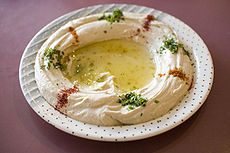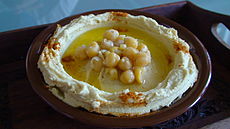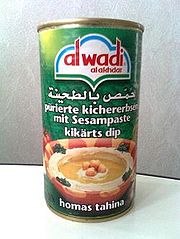- Hummus
-
This article is about the food. For the band, see Humus (band). For the organic matter in soil, see Humus.
Hummus 
Hummus with olive oil, lemon juice, cumin and za'atar (with sumac)Origin Place of origin Levant Dish details Course served Meze Serving temperature Cold Main ingredient(s) Chickpeas, tahini Hummus is a Levantine Arab food dip or spread made from cooked, mashed chickpeas, blended with tahini, olive oil, lemon juice, salt and garlic.[1][2] It is popular throughout the Middle East and in Middle Eastern cuisine around the globe.
Contents
Etymology
The English word comes from Turkish humus meaning the hummus food dip or spread, which in turn comes from Arabic حمّص ḥummuṣ, in turn derived from ḥimmaṣ "chickpeas".[3] The earliest known attestation for hummus in English is in 1955.[4] Spellings of the word in English can be inconsistent.[5] Among the spellings are hummus, houmous, hommos, humos, hoummos, etc. The spelling humus is generally avoided in English as it is a homonym of humus (organic matter in soil), though this is the usual Turkish spelling[5] and the OED indicates the word entered the English language from Turkish.[4] The chickpea in Turkish has the unrelated name nohut. The Arabic name of the prepared spread is حمّص بطحينة ḥummuṣ bi ṭaḥīna which means "chickpeas with tahini".
History
Many cuisine-related sources describe hummus as a very ancient food,[6][7][8] or connect it to famous historical figures such as Saladin.[9] Indeed, its basic ingredients—chickpeas, sesame, lemon, and garlic—have been eaten in the region for millennia.[10][11]
But in fact, there is no specific evidence for this purported ancient history of hummus bi tahini.[12] Though chickpeas were widely eaten in the region, and they were often cooked in stews and other hot dishes,[13] puréed chickpeas eaten cold with tahini do not appear before the Abbasid period in Egypt and the Levant.[14]
The earliest known recipes for something similar to hummus bi tahini date to 13th century Egypt. A cold purée of chickpeas with vinegar and pickled lemons with herbs, spices, and oil, but no tahini or garlic, appears in the Kitāb al-Wusla ilā l-habīb fī wasf al-tayyibāt wa-l-tīb;[14] and a purée of chickpeas and tahini called hummus kasa appears in the Kitab Wasf al-Atima al-Mutada: it is based on puréed chickpeas and tahini, and acidulated with vinegar (though not lemon), but it also contains many spices, herbs, and nuts, and no garlic. It is also served by rolling it out and letting it sit overnight,[15] which presumably gives it a very different texture from hummus bi tahini.
The earliest known documentation of hummus in the modern form comes from a late 19th-century text; and it appears it was unknown outside Damascus at that time.[2]
Nutritional information
Hummus, commercial Nutritional value per 100 g (3.5 oz) Energy 695 kJ (166 kcal) Carbohydrates 14.3 Fat 9.6 Protein 7.9 Percentages are relative to US recommendations for adults.
Source: USDA Nutrient DatabaseHummus is high in iron and vitamin C and also has significant amounts of folate and vitamin B6.[16] The chickpeas make it a good source of protein and dietary fiber; the tahini consists mostly of sesame seeds, which are an excellent source of the amino acid methionine, complementing the proteins in the chickpeas. Depending on the recipe, hummus carries varying amounts of monounsaturated fat.[17] Hummus is useful in vegetarian and vegan diets; like other combinations of grains and pulses, it serves as a complete protein when eaten with bread.
Serving methods
As an appetizer and dip, hummus is scooped with flatbread (such as pita). It is also served as part of a meze or as an accompaniment to falafel, grilled chicken, fish or eggplant. Garnishes include chopped tomato, cucumber, cilantro, parsley, caramelized onions, sautéed mushrooms, whole chickpeas, olive oil, hard-boiled eggs, paprika, sumac, ful, olives, pickles and pine nuts (as photographed in the "History" section). Outside the Middle East, it is sometimes served with tortilla chips or crackers.
Hummus ful (pronounced [ˈfuːl]) is topped with a paste made from fava beans boiled until soft and then crushed. Hummus masubha/mashawsha is a mixture of hummus paste, warm chickpeas and tahini.
In Vegetarian Dishes from the Middle East, Arto der Haroutunian calls hummus "one of the most popular and best-known of all Syrian dishes" and "a must on any mezzeh table."[18] Syrians in Canada's Arab diaspora prepare and consume hummus along with other dishes like falafel, kibbe and tabouleh, even among the third and fourth-generation offspring of the original immigrants.[19]
Palestinian
For Palestinians, hummus has long been a staple food, often served warm.[20] All of the ingredients in hummus are easily found in Palestinian gardens, farms and markets, thus adding to the availabilty and popularity of the dish. In Palestine, hummus is usually garnished, with olive oil, "nana" mint leaves, paprika, parsley or cumin.[21] A related dish popular in the region of Palestine and Jordan is laban ma' hummus ("yogurt and chickpeas"), which uses yogurt in the place of tahini and butter in the place of olive oil. Hummus is served with pita bread and is eaten for breakfast, lunch or dinner.
Israeli
Hummus is a common part of everyday meals in Israel.[22] Israelis elevated Hummus to become a "national food symbol" and consume more than twice as much hummus as their Arab neighbors, according to figures by Tsabar Salads, a hummus manufacturer in Israel.[23] Commenting on its popularity, Gil Hovav, an Israeli food editor interviewed on the BBC program Cooking in the Danger Zone, stated that "even during the intifada years Jews would sneak [...] into the Muslim quarter just to have a vital, really genuine good humous [sic]," and noted that like many dishes considered to be Israeli national foods, hummus is actually Arab.[24] However, he also said, commenting on Iraqi, Egyptian, Syrian or Yemeni food in Israel, that "Jews came from these countries to Israel and they brought their food with them".[25] Many restaurants run by Mizrahi Jews and Arab citizens of Israel are dedicated to hot hummus, which may be served as chick peas softened with baking soda along with garlic, olive oil, cumin and tahini. One of the fancier hummus versions available is hummus masabacha, made with lemon-spiked tahini garnished with whole chick peas, a sprinkling of paprika and a drizzle of olive oil.[26] Hummus is sold in restaurants, supermarkets and hummus-only shops (known in Hebrew as humusiot).
Packaged product
United States
By the end of the 20th century, hummus had emerged as part of the American culinary fabric.[27] In 2008, more than fifteen million Americans consumed hummus on a regular basis.[27] Hummus was popularized in the United States by Jews returning from visits in Israel and by Israeli expatriates.[27]
According to a 2010 market research, hummus consumption in the United States has increased by 35% over a period of 21 months, with sales reaching nearly $300 million. In 2006, hummus was present in 12% percent of American households, rising to 17% by early 2009.[28] One commentator attributed the growth of Hummus to America’s embrace of ethnic foods, and to experimentation with exotic foods.[28]
In November 2009, Gadi Lesin, President & CEO of the Israeli Strauss group food manufacturer said that market share of co-owned Sabra Dipping Company in the USA makes it the largest packaged hummus dip manufacturer in the world.[29]
Controversy
Lebanese produced hummus in a can, sold in Sweden.
In October 2008 the Association of Lebanese Industrialists petitioned to the Lebanese ministry of Economy to request protected status from the European Commission for hummus as a uniquely Lebanese food, similar to the Protected Geographical Status rights held over regional food items by various European Union countries.[30][31][32] Fadi Abboud (president of the Lebanese Industrialists Association), stated that "Israelis have usurped several Lebanese and oriental products",[1]. According to Abboud, Lebanon exported the first hummus dish in 1959.[33] As a response, food critic Janna Gur wrote: "The success of certain brands of Israeli hummus abroad may have been what brought about Abboud's anger", leading him to claim that Israel has been "stealing" their country's national dishes, like hummus, falafel, tabbouleh and baba ghanouj.[34] In response, Shooky Galili, an Israeli journalist specialising in food who writes a blog dedicated to hummus,[2] said that "trying to make a copyright claim over hummus is like claiming for the rights to bread or wine. [...] Hummus is a centuries old Arab dish—nobody owns it, it belongs to the region."[35] As of late 2009, the Lebanese Industrialists Association was still "preparing documents and proof" to support its claim.[36]
World record
In May 2010, the Guinness World Record for the largest dish of hummus in the world returned to Lebanon.[35][37] The winning dish, cooked by 300 cooks in the village of al-Fanar, near Beirut, weighed 10,452 kg (22,994 lbs, equal to 11.5 U.S. tons), more than double the previous record set by 50 Israeli Arabs and Jews who cooked 4,087.5 kg (8992.5 lbs) in January 2010 in the Arab-Israeli village of Abu Ghosh.[38][39][40] According to local media, the recipe included 8 tons of boiled chick peas, 2 tons of tahini, 2 tons of lemon juice and 70 kg (154 lbs) of olive oil.[35]
See also
References
- ^ Sami Zubaida, "National, Communal and Global Dimensions in Middle Eastern Food Cultures" in Sami Zubaida and Richard Tapper, A Taste of Thyme: Culinary Cultures of the Middle East, London and New York, 1994 and 2000, ISBN 1-86064-603-4, p. 35.
- ^ a b James Grehan (2007). Everyday Life and Consumer Culture in Eighteenth-Century Damascus, p. 107. ISBN 029598676X.
- ^ Maan Z. Madina, Arabic-English Dictionary of the Modern Literary Language, 1973, s.v. ح م ص
- ^ a b Oxford English Dictionary (Second Edition) online version, September 2011, Oxford, Oxford University Press
- ^ a b Pam Peters (2007), The Cambridge Guide to Australian English Usage, Cambridge University Press, pp. 370, ISBN 0521878217
- ^ mideastfood.about.com, Hummus 101, retrieved 28 February 2008
- ^ choice.com, More about hummus, "Hummus has existed for thousands of years." retrieved 5 May 2008
- ^ insidehookah.com Food - Hummus, "...it is evident that it’s been a Middle Eastern/Mediterranean favorite, and sometimes staple, for thousands of years." retrieved 5 May 2008
- ^ Percival, Jenny, Lebanon to sue Israel for marketing hummus as its own, guardian.co.uk, 7 October 2008, retrieved 9 November 2009
- ^ Tannahill p. 25, 61
- ^ Brothwell & Brothwell passim
- ^ www.straightdope.com, Who invented hummus?, 21 March 2001, "Hummus has been around for too long, in too many forms, and the origin is lost in antiquity... There's no way of knowing where it started...", retrieved 5 May 2008
- ^ e.g. a "simple dish" of meat, pulses and spices described by Muhammad bin Hasan al-Baghdadi in the 13th century, Tannahill p. 174
- ^ a b Lilia Zaouali, Medieval Cuisine of the Islamic World, University of California Press, 2007, ISBN 978-0-520-26174-7, translation of L'Islam a tavola (2004), p. 65
- ^ Perry et al., p. 383
- ^ Bricklin, 1994, p. 115.
- ^ Hummus NutritionData.com
- ^ Arto der Hartoiunian Vegetarian Dishes from the Middle East, London 1983, p.33.
- ^ Paul R. Magocsi (1999), Encyclopedia of Canada's Peoples, University of Toronto Press, pp. 1244, ISBN 0802029388, http://books.google.com/?id=dbUuX0mnvQMC&pg=PA1244&dq=falafel+history
- ^ Salloum and Peters, 1996, p. 204.
- ^ Ibrahim, Lailie, Institute for Middle East Understanding, Hummus, a Palestinian staple, 31 March 2006, retrieved 9 March 2008.
- ^ Even mentioned by the Israel Defense Force Cookbook, see Houston Chronicle "Diversity in the dining room helps ring in Israel's new year"
- ^ Hummus brings Israelis, Palestinians to the table, The Christian Science Monitor, By Joshua Mitnick, July 25, 2007
- ^ BBC Cooking in the Danger Zone: Israel and Palestinian Territories, pp. 5-6: "Humous is Arabic. Falafel, our national dish, our national Israeli dish, is completely Arabic and this salad that we call an Israeli Salad, actually it's an Arab salad, Palestinian salad."
- ^ Cooking in the Danger Zone: Israel and Palestinian Territories, page 3
- ^ Food & Wine, May 2008; On the Hummus Hunt in Israel by Jen Murphy, p. 66,
- ^ a b c Marks, Gil (2010), Encyclopedia of Jewish Food, John Wiley and Sons, pp. 269-271
- ^ a b There’s Hummus Among Us By Elena Ferretti, Fox News, April 05, 2010
- ^ Aviv Levy (25 November 2009), זינוק במכירות חומוס שטראוס בארה"ב: כבשה 40% מהשוק, Globes, http://www.globes.co.il/news/article.aspx?QUID=1055,U1259186350557&did=1000517051, retrieved 25 November 2009(Hebrew)
- ^ Karam, Zeina, "Hummus war looms between Lebanon and Israel", Associated Press, 7 October 2008, retrieved 10 December 2008.
- ^ Carolynne Wheeler (11 October 2008), "Hummus food fight between Lebanon and Israel", The Daily Telegraph, http://www.telegraph.co.uk/news/worldnews/middleeast/3178040/Hummus-food-fight-between-Lebanon-and-Israel.html
- ^ "Whose hummus is it anyway?", The Times of South Africa, November 9, 2008, http://www.thetimes.co.za/PrintEdition/Lifestyle/Article.aspx?id=877641
- ^ YaLIBNAN. JANUARY 9, 2010. http://www.yalibnan.com/2010/01/09/hummus-war-between-lebanon-israel-escalates/. Retrieved 4 July 2010.
- ^ Gur, Janna (cited as 'Jana'), Santa Fe New Mexican, "Hummus History: Tales of a Wandering Chickpea", 21 October 2008, retrieved 11 December 2008
- ^ a b c Lebanon claims latest title in 'Hummus War' (CNN)
- ^ "Lebanese score in hummus war with Israel", Associated Press, 24 October 2009
- ^ "Lebanon breaks Israel's hummus world record". Yahoo. AP. 8 May 2010. http://ca.news.yahoo.com/s/capress/100508/world/ml_lebanon_hummus_record.
- ^ "Abu Gosh mashes up world's largest hummus". YNet. AFP. 8 January 2010. http://www.ynetnews.com/articles/0,7340,L-3830318,00.html.
- ^ "Abu Ghosh secures Guinness world record for largest dish of hummus". Israel Ministry of Foreign Affairs. 11 January 2010. http://www.mfa.gov.il/MFA/Israel+beyond+politics/Abu_Ghosh_secures_Guinness_record_hummus_11-Jan-2010.htm. Retrieved 31 March 2010.
- ^ Jack Brockbank (12 January 2010). "The largest serving of hummus". Guinness World Records. http://community.guinnessworldrecords.com/_The-largest-serving-of-hummus/BLOG/1713298/7691.html. Retrieved 31 March 2010.
Bibliography
- Afzal-Khan, Fawzia; Seshadri-Crooks, Kalpana (2000), The Pre-occupation of Postcolonial Studies, Duke University Press, ISBN 0822325217, 9780822325215
- Amster, Linda; Sheraton, Mimi (2003), The New York Times Jewish Cookbook: More Than 825 Traditional and Contemporary Recipes from Around the World, St. Martin's Press, ISBN 0312290934, 9780312290931
- Bricklin, Mark (1994), Prevention Magazine's Nutrition Advisor: The Ultimate Guide to the Health-Boosting and Health-Harming Factors in Your Diet, Rodale, ISBN 0875962254, 9780875962252
- Brothwell, C. D.; Brothwell, B. (1998), Food in Antiquity: A survey of the Diet of Early Peoples, Expanded Edition, Johns Hopkins University, ISBN 0801857406
- Marks, Gil (2010), Encyclopedia of Jewish Food, John Wiley and Sons, pp. 269–271
- Rodinson, Maxime; Perry, Charles (1998), Medieval Arab Cookery, Prospect Books (UK), ISBN 0907325912, 978-0907325918
- Salloum, Habeeb; Peters, James (1996), From the Lands of Figs and Olives: Over 300 Delicious and Unusual Recipes, I.B.Tauris, ISBN 1860640389
- Tannahill, Reay (1973), Food in History, Stein and Day, ISBN 0517571862
Further reading
- McKenna, Alix. "Lebanon vs. Israel: A Delicious Culinary War", Moment, March/April 2011.
- Ottolenghi, Yotam. "The perfect hummus debate", The Guardian, June 29, 2010.
Categories:- Arab cuisine
- Arabic loanwords
- Levantine cuisine
- Appetizers
- Dips
- Spreads
- Legume dishes
- Vegan cuisine
- Hummus
Wikimedia Foundation. 2010.




